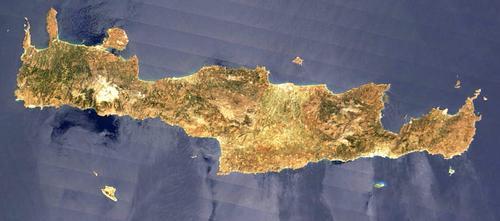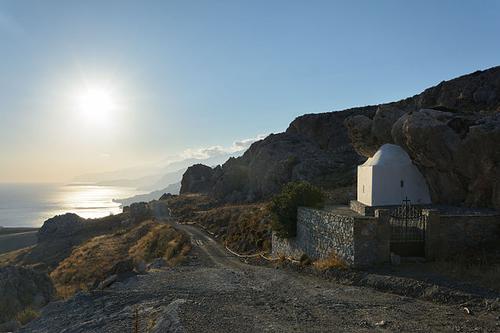CRETE

Cities in CRETE
| Chersonissos |
Popular destinations GREECE
| Aegina | Alonissos | Andros |
| Chios | Corfu | Crete |
| Hydra | Kalymnos | Karpathos |
| Kefalonia | Kos | Lefkas |
| Lesbos | Mykonos | Naxos |
| Paros | Patmos | Peloponnese |
| Poros | Rhodes | Samos |
| Santorini | Skiathos | Skopelos |
| Spetses | Thasos | Zakynthos |
Geography
Crete (New Greek: Kréte; pronunciation: Kríti; Latin: Creta), is a Greek island in the Mediterranean Sea and an administrative region, 8336 km2 in size. Crete is the largest island in Greece and is the fifth largest island in the Mediterranean Sea after Sicily, Sardinia, Corsica and Cyprus.

The island is 260 kilometres long and has a maximum width of 60 kilometres. The most important cities are Iraklion and Chanía. The coast of North Africa is 300 kilometres away, the Greek mainland 100 kilometres and Athens 250 kilometres to the north-west. Crete lies on the border of the Aegean Sea in the north and the Libyan Sea in the south. Apart from Gavdos, which belongs to Crete, Crete is the southernmost island in Europe. Several tens of millions of years ago, Africa began to move towards Europe and the African plaice pushed up against the European plaice. A number of islands arose on the border, including Crete, Kasos and Karpathos.
The Crete of today was formed only a few million years ago, in the Pliocene. At the location of the present Mediterranean Sea, Crete was a mountain ridge in a desert basin. When the Strait of Gibraltar opened up, water from the Atlantic Ocean entered the basin and a number of islands, including Crete, remained. The African plaice is still advancing and regularly causes earthquakes on Crete and surrounding areas. The last big earthquake dates from 1926.
Landscape
The very mountainous Crete is part of the chain between the Dinaric Alps in the south-west of the Balkans and the Taurus Mountains in Turkey. The island is largely made up of limestone mountains, some of which are karst, in the west the Levka Mountains (Levká Óre or White Mountains) with the highest peak being Páhnes (2453 metres), In the middle, the Íde Óros or Pséloreítes with the highest peak Psilorítis or Timíos Stavrós (2456 metres high, the ancient Ida) and in the east the plateau of Lassíthi with the highest peaks Díkti (2148 metres) and Aféndis Hristós (2141 metres).
 Sunset seen from the top of Timíos Stavrós, CretePhoto: Uoaei1 CC 4.0 International no changes made
Sunset seen from the top of Timíos Stavrós, CretePhoto: Uoaei1 CC 4.0 International no changes made
The total coastline is about 1050 kilometres long. The south coast rises steeply from the sea and along the north coast is a hilly area with low plains and bays. This is where the larger cities are located and where most of the tourists are. Furthermore, there are some fertile lowlands between the mountains, of which the Pediás Mesarás, in the south of central Crete, is the most important because it is the granary of Crete. This lowland is some 60 kilometres long with an average width of 5 kilometres. Other plateaus include the Omalós Plain, the Askífou Plain and the Nída Plain. Large areas of Crete are bare and rocky and this landscape is called "phrygana".
The mountains of Crete consist mainly of various permeable limestones, which have created about 3000 (dripstone) caves, among others the Idaic cave, the Kamáres cave and the Zonianá cave. Crete also has a number of special gorges of which the most famous is the 18 kilometre long Samariá gorge, the longest gorge in Europe. Other gorges include the Topólia Gorge and the Kourtaliótiko Gorge.
A number of unnavigable rivers cut through the Cretan land, but are usually dry in the summer. The main rivers are the Tiflós, the Geropótamos and the Anapodáris. Southwest of Rethymnon is the island's only lake, Lake Kournas.Crete has many beaches. The busiest and most accessible beaches are in the north. The south coast also has some beautiful beaches. The small and often remote beaches are located in bends and coves.
Around Crete there are some small islands. Along the north coast Gramvoúsa, Día, Psíra and Ag; along the east coast Dragonáda and Grántes; along the west coast Elafonísi; along the south coast Hrisí, Gaúdos (the largest island) and Koufonísi. In the west are well-known peninsulas such as Rodópou and Akrotíri and in the east Spinalónga.
Ierapetra (approx. 15,000 inhabitants), located on the south coast of Crete, is not only the southernmost town of Crete and Greece, but also of Europe
Sources
Buma, H. / Reishandboek Kreta
Elmar
Hendriksen, B. / Kreta
Babylon-De Geus
Lubsen-Admiraal, S.M. / Kreta
Kosmos
Strijbos, E. / Kreta
Gottmer/Becht
CIA - World Factbook
BBC - Country Profiles
Copyright: Team The World of Info